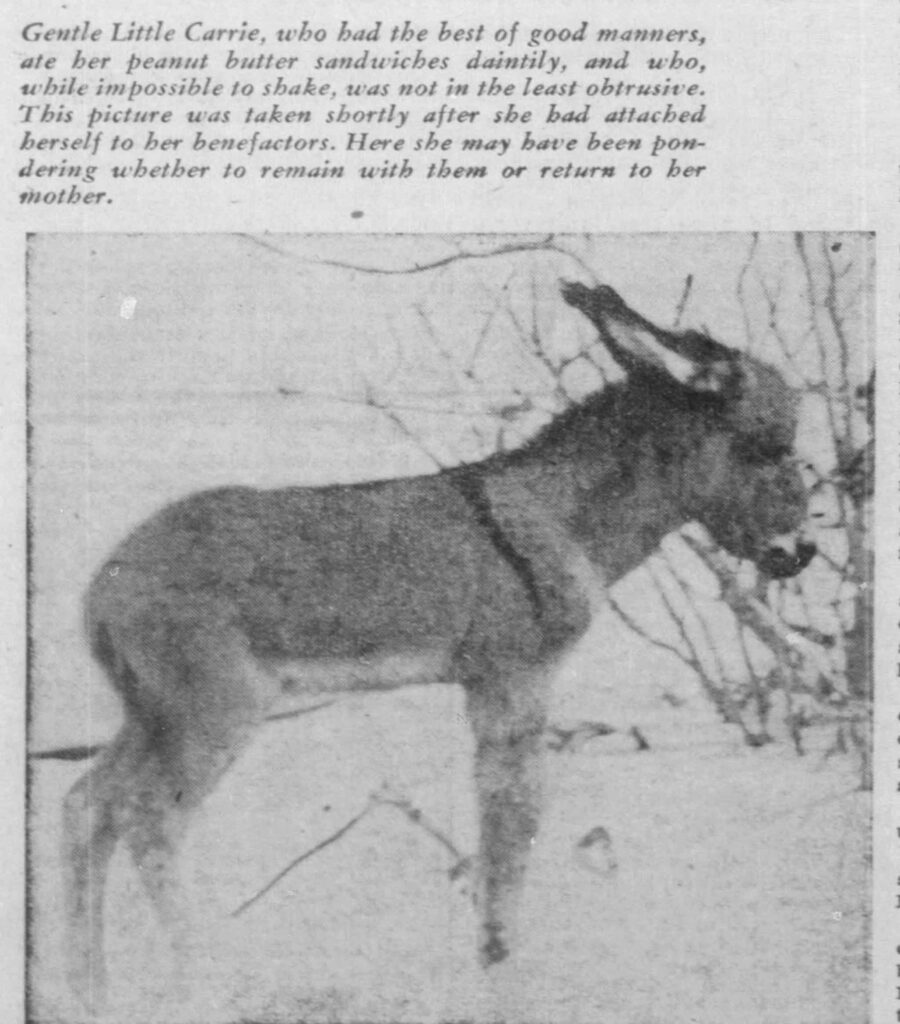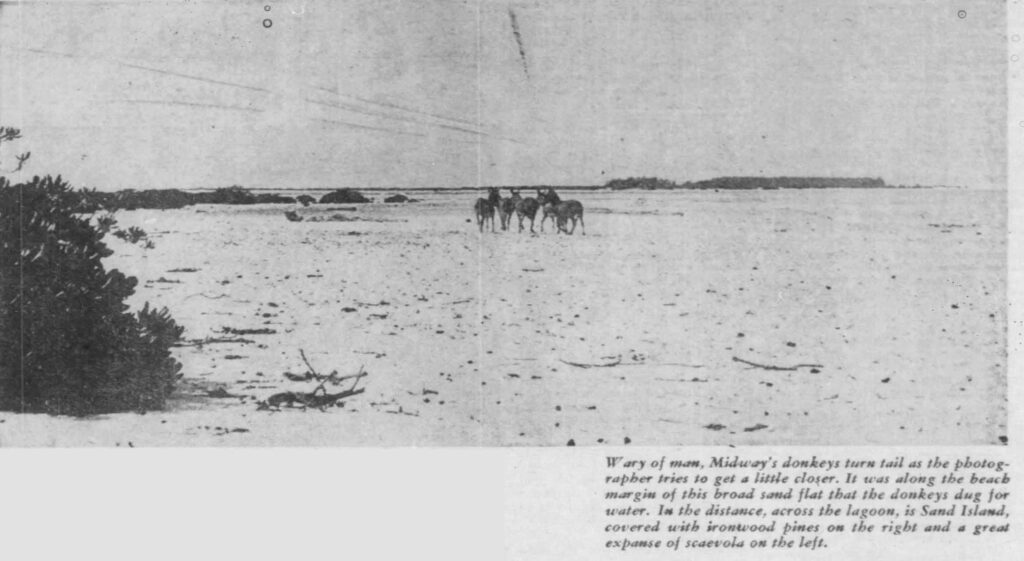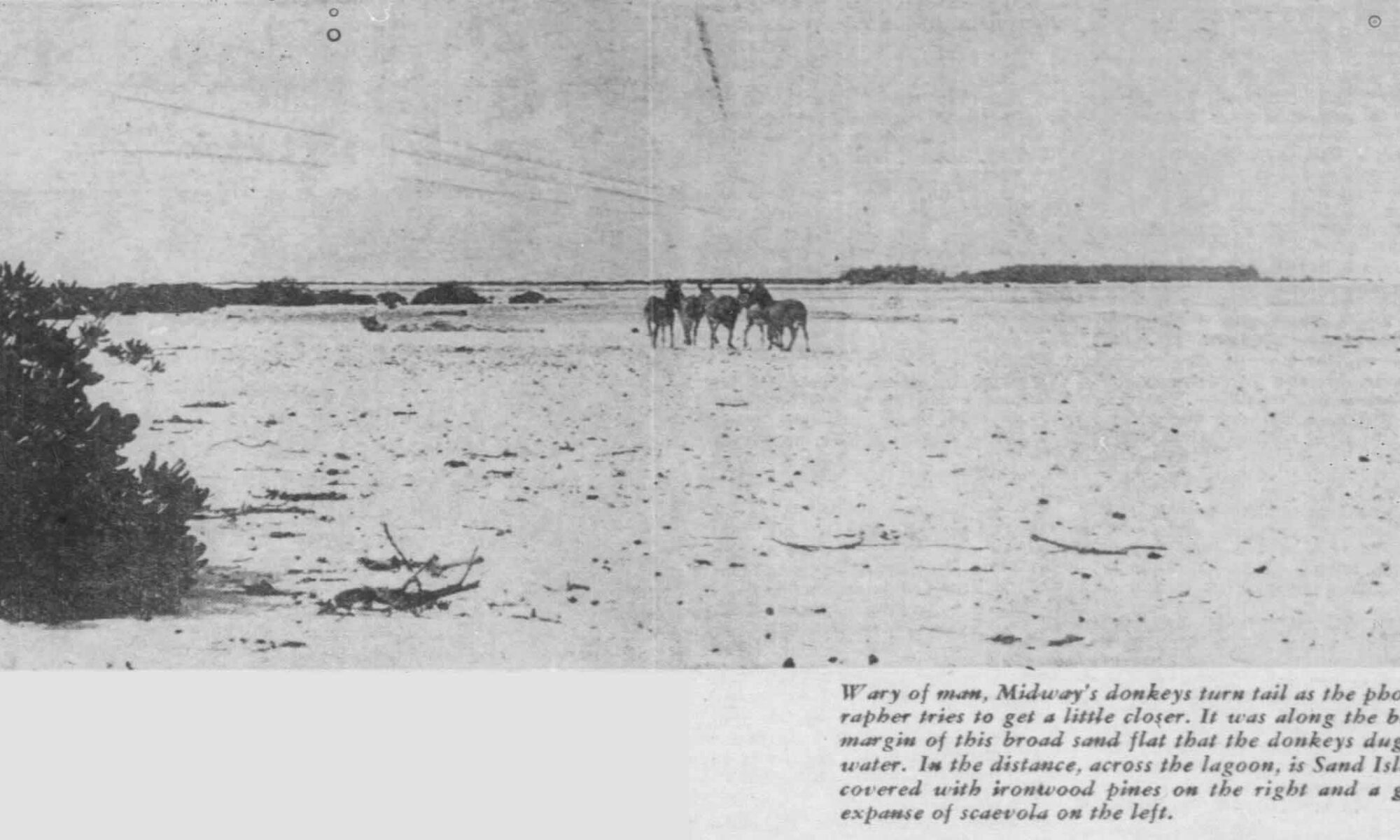I cry whenever I read about Carrie and the donkeys of Midway.
Not to get too philosophical or emotional but, as strange as it sounds, the story of Carrie, Dowie, and Little Carrie says something profound about the nature of life on remote Midway. It reminds us that endurance and loneliness are universal—whether you’re a sailor, a doctor with a wooden leg, or a donkey stranded on a speck of coral in the middle of the Pacific. Their cries, their resilience, and even their silence are part of Midway’s soul now, echoing across time like the wind over the islands.
Maybe that’s the lesson they left behind: that even the smallest lives, lived in the most forgotten corners of the world, can touch the heart in ways that never fade. The story of these little donkey’s touched my heart.
<<<>>>

Those Donkeys of Midway
By Donald R. Chisholm — Honolulu Star-Bulletin, May 14, 1955
Gone are the burros that once eked out a meager existence on the lonely atoll of Midway. But not gone is the memory of their struggle—for water, for food, for life.
The author knew the donkeys personally. He served as medical officer with the Commercial Pacific Cable Company on Midway in 1928–29 and again in 1930–31; later Medical Resident at Queen’s Hospital (1932), resident physician at Leahi Hospital (1933–1941), and medical director of Mahelona Hospital, Kauai (1941–1953).
Tolls and isolation can get under a man’s skin, and in earlier days some disillusioned sojourners on Midway jokingly called themselves “jackasses.” But the Midway story here is about the real quadrupeds—the common domestic donkey, Equus asinus—colloquially nicknamed the Eastern Island Nightingale.
Among the early “colonists” were Carrie and Dowie. Carrie took her name from the hatchet-wielding temperance crusader Carrie Nation; Dowie honored an itinerant clergyman of the era. They came for a single purpose and, having served it well, lived out the balance of their days without aim or direction—lives of patience and endurance under driving rain, blistering sun, and howling hurricanes; of fleeting passions, brief maternal love, and long, dreary isolation.
On July 4, 1903, the submarine cable between the United States and the Philippines officially opened. To operate it, the Commercial Pacific Cable Company established relay stations in Honolulu and on Sand Island, Midway—then a barren expanse of dunes and flats, quite unlike nearby Eastern Island across the lagoon. Sand Island’s advantages were height, lagoon protection, and, most importantly, rainwater stored in deep sand.
A company doctor—a man with a wooden leg—was hired to care for station personnel. His peg leg sank into the soft sand and hampered movement. Resourcefully, he asked the captain of the station’s supply ship to bring a donkey from Honolulu. The obliging captain returned with two: Carrie and Dowie. Thanks to their patient labor, the doctor could roam the island freely.
When his year ended, he returned to the mainland. By then the donkey population had become three. Since they damaged gardens, cost money to maintain, and were no longer needed as mounts, they were banished to Eastern Island—greener than Sand, but harsher than it first appeared. There their destiny was to bray and breed, earning the ironic title “Eastern Island Nightingales.”
Life on Eastern Island
Eastern Island held perils. The ground was riddled with petrel burrows—treacherous pitfalls where a donkey might break a leg. Birds were the donkeys’ constant company; turtles and seals sometimes hauled out, but showed only indifferent curiosity. Outcasts among birds and sea creatures, the donkeys kept to their own, typically roaming in two bands—a loose sorority and fraternity.
Water was the endless problem. Like Coleridge’s mariner, they knew “water, water everywhere—nor any drop to drink.” A brackish pool sometimes formed after heavy rains at the island’s southwest tip, but it was intermittent—easily flooded by salt water or buried by sand. The juicy leaves of scaevola (naupaka) supplied emergency moisture. Nocturnal showers are frequent on Midway, and heavy rains not uncommon; the donkeys likely browsed most when foliage was wet.
Coral islands with adequate rainfall and fine sand can hold a freshwater lens. Eastern Island’s sand is coarse, with poor capillary retention—but fresh water could be had for a time after heavy rains. As far back as 1867, when the U.S.S. Lackawanna claimed Midway, the ship’s surgeon reported wells dug 4–7 feet deep on both islands, with water improving after standing.
The donkeys knew it, too. In desperate spells they dug wells near the beach: a donkey would kneel and scratch down with the other forefoot. It was pathetic to watch them toil for hours to four or five feet, only to find the hole dry—walls caving, the beast standing over damp sand, sniffing for a trickle that didn’t come. Sometimes three or four would gather around a barely moist pit, heads low, ears drooping—the picture of despair. Yet despite the thirst, the herd persisted for decades, into the early 1930s—evidence that while they suffered, they did not as a rule die of thirst.
Like wild asses of Asia and Africa, the Eastern Island donkeys were swift-footed and wary. They were never molested, but they were vigilant, scent-sure, and suspicious. Close-up photographs of adults proved nearly impossible. The author did, however, befriend a young filly, which taught him much about the humble donkey.
One fine morning, two cablemen and the author paddled a canoe from Sand to Eastern Island to fish, shoot enough for a deep pot pie, and photograph birds. They spotted a very young colt lingering near a herd. The herd bolted; the mother hovered at a distance. They caught the foal easily. After a few minutes of petting, the youngster lost all fear and followed them to the canoe. They fed her lump sugar, a sandwich, and a quart of water—which she took with painful eagerness. Discovering she was a filly, they named her Little Carrie, in honor of the long-deceased ancestress.
All day Little Carrie shadowed them with perfect manners—daintily eating peanut-butter sandwiches—while the dam watched from afar, then rejoined the herd. Late in the afternoon, preparing to paddle back, the men faced a decision. It would be wrong to abduct the filly from her mother, and Sand Island—then a lush garden compared to Eastern’s desert—would be a cruel paradise to taste and lose. They gave her the last of the sugar and sandwiches, and another quart of water—perhaps the last good drink she ever had.
They pushed off. Little Carrie tried to climb into the canoe, getting both forefeet over the gunnel before they lifted her out. As they drifted 30 feet from shore, she cried—not brayed, but wept, with the sobbing dissonance of a heartbroken child. It stilled them. Then she walked into the lagoon, quickly beyond her depth—she could not swim—and went under. They hauled her out, shoved off again; again she cried, again she waded out, again she sank, and again they rescued her. The third time, she stayed ashore, her cries following them far across the lagoon.
They never saw Little Carrie again. They wondered if her mother reclaimed her, if she died of a broken heart, or if she tried a third time and drowned. Perhaps they erred in not taking her.
Meanwhile, Carrie and Dowie’s first impressions of Eastern Island faded. After the purslane centers were grazed down, the scaevola diet grew monotonous; thirst was new to beasts used to Sand Island’s water. The merciless sun, cold rains, lack of shelter, occasional hurricanes that flattened vegetation, heaped rocks on the southeast beach, and drove salt water deep into the scaevola—all took their toll. The blowflies that cleaned bird carcasses didn’t harm the donkeys but were a constant annoyance.
Worst of all was the confinement of their island pound. No fence hemmed them, no halter chafed them, and no burden strained their backs; yet in all directions the Pacific moat stretched to the horizon. Across the lagoon lay Sand Island—the realm of the “human animal”—but between lay a lot of water and many sharks. The donkeys watched flocks of birds come and go. Did they wonder where? Did they envy them? Did time mean anything to a donkey? The author wasn’t sure—until he remembered Little Carrie.
Their trials, yearnings, and brief joys ended sometime in the early 1930s. No one knows exactly what caused the extinction of the herd, and speculation is futile. Soon after, Eastern Island was prepared for war—men, bulldozers, and airplanes moved in. It was just as well the donkeys were already gone.
In a way, extinction was a kind of reward; the donkeys had borne the bitterness of exile with a fortitude that deserved its rest. At least one member of the clan—Little Carrie—stirred human compassion, left memories still strong after a quarter-century, and proved that her kind is more lovable and intelligent than tradition allows. Perhaps the peg-leg doctor would have christened her Stella—Star of the Eastern Island Nightingales.


